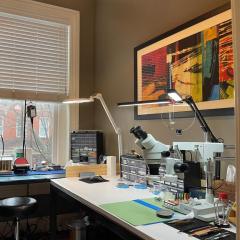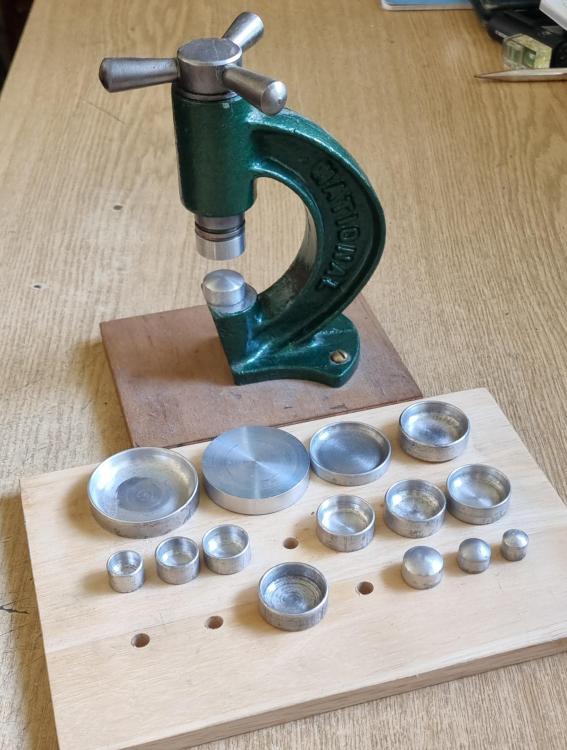-
Posts
2148 -
Joined
-
Last visited
-
Days Won
70
Marc last won the day on November 23 2023
Marc had the most liked content!
Profile Information
-
Gender
Male
-
Location
Northampton, England
Marc's Achievements
-
Small but (I think) very good looking watches. I have a couple of them although mine have the Wostok 2209 movements inside. https://watchmender.wordpress.com/2023/01/28/sekonda-field-watch-wostok-2209/#more-484
-

Problem with elma red
Marc replied to frog54's topic in Cleaning / De-Greasing Techniques - including cleaning products
I doubt that's rust as the main plate is unlikely to be steel or any other ferrous alloy, it's most likely plated brass. Unless something else has been deposited onto the surface it looks to me like the cleaner has started to strip the plating off the brass. How long did you leave it in the cleaner, and at what temperature? -
Certainly an ambitious price This is a sold price https://www.ebay.co.uk/itm/226263423357?_nkw=crystal+press&itmmeta=01J5WBCFZCF0A8RF9ARCXMC717&itmprp=enc%3AAQAJAAAA8HoV3kP08IDx%2BKZ9MfhVJKn8D%2BW%2FVEkRZYdjKvUPOfskDP2NOyMu5imRSKeKmO2W854raCd4nNt6iiSOyFtfMAOATIl8Sv6j5H7ecDGaJIqyTFFuUruRd9md%2FBBPstzuxtlax4lEHtAnT%2BSCARLedCupDIE9J2xCMMmLS7RavqykEFjWbrQ9TF2P0Lm%2F5Kg6qDqp5VKt0AGvzmm25nI%2BDQokmWlwKeJYdHdjvYcdVEZBI6LSXF3MiqPW2O%2B0ih%2FqI2LjBMrzY9nc9G%2BcgM2ZeVXRRIeS8Gx64wl%2BITTUyuAUoW0oK0JgHq0F394D2h8vmw%3D%3D|tkp%3ABk9SR-r_sYuvZA&LH_ItemCondition=4
-
Absolutely, this is my National press. I have seen these go for less than £10 on eBay in the past and it is a great piece of kit. I only have plastic and Bakelite dies for the Robur which are fine for standard crystals but the edges are a little too delicate for things like press on bezels and case backs. The National only has aluminium dies (I also have a few brass ones that can be adapted) so this gets used for more demanding tasks, but it would only require minimal modification for your dies to fit and you would then have a very viable alternative to the Robur at a fraction of the price.
-
Prepare to be extremely surprised. I can't claim to have the experience of a seasoned professional who's been at the bench for 40 years, but I have been practicing this wonderful craft as a hobbyist for about 20 years, averaging a couple of watches a month, so I have a sample size of more than just a handful of examples to go on. I can't say that I have ever come across.... I have encountered a few (I would say less than 10) grossly over oiled movements, but even on those, "dirt and grease laden threads" were not a feature. I find it hard to imagine a mechanism by which threads would even become so contaminated, unless someone actually purposefully oiled them (?????). Even excess lubrication migrating from places where there should be oil is unlikely to find its way into screw holes, let alone in sufficient quantities for the threads to become "laden". Still, we all have different experiences and I guess that I must be sourcing my victims from a cleaner and less oily source than some other folks. As I previously said if there is rust involved then it's a different matter. Note: I have actually come across a couple of examples of grossly contaminated threaded holes (dirt, not oil), but only in un-cased movements that have been rattling around unprotected in someones parts bin for a few decades.
-
An interesting and valid observation. However, I first of all can't imagine how the threads might become dirty or contaminated in the first place, and secondly I can't see that it would matter much if they did. Obviously if there is rust involved then that would need to be addressed, as would any contamination that might cause the threads to bind or which could cause other damage in the watch. Other than rust though I have never come across threads that particularly needed cleaning. These are static, un-lubricated parts so it's hard to see how failing to clean them as individual pieces could be detremental to their function, and to me the pro's far outweigh the con's. None the less, this is watchmaking so is guaranteed to garner differences in approach and opinion, all equally valid
-
I have a different approach to @RichardHarris123 and @oldhippy in that I return screws to their respective holes once the part that they were securing has been removed. This not only prevents losing screws but also helps to ensure that the screws all end up back in the right place, assuming of course that they were in the correct location to start with
-

Braking grease - a myth?
Marc replied to Kalanag's topic in Lubrication Techniques, Oils, Greases, Epilame Treatments
An interesting test indeed. However with at least one dangerous assumption, and one omission. The assumption being that "fresh from the factory" equates to appropriately lubricated with a braking grease. Had this been of Swiss or Japanese origin then the assumption may not have been as problematic, however my understanding (and I will confess this is from reading not direct experience) is that one of the problems with the Chinese movements is the lack of appropriate, or even any, lubrication. The omission being to repeat the test with a known braking grease applied, which would have negated the assumption and given a known and verifiable result for braking grease. 10 out of 10 though for experimenting. -
Not at all. What I am saying is that the effect of magnetism in a scenario where the coils do not stick together is significantly less the impact that sticking coils has. I'm certainly not trying to suggest that magnetism has no discernible effect. It's interesting to note the differences between Alex's magnetised trace in his video, which I would (rightly or wrongly, I'm happy to learn) attribute to a shortened effective hair spring length and the wavy traces you presented above which might be explained by magnetised wheels with poles whose orientations change relative to each other periodically as the wheels turn relative to each other. @praezis there's nothing like a bit of experimentation, and while you were posting your link (worth a read) I was torturing an old Nivarox hair spring from an ETA 2879 with the neodymium magnet out of an old hard drive to see if I could get the coils to stick together, and I couldn't. The spring was deflected by the magnetic field but nothing stuck. I had no means of measuring the degree to which the H/S was actually magnetised though so not very scientific, and it may not have become magnetised at all.
-
Indeed, and I believe that this very effect is used by Seiko to regulate its Spring Drive movements. However, to generate a sufficient braking force the Spring Drive regulator uses what appear to be fairly substantial coils and presumably spinning permanent magnets to work. With a magnetised hair spring in a conventional escapement the hair spring isn't spinning, so neither is the magnetic field, in fact it's really only moving by a tiny amount in and out as the spring breaths, and there are no coils, just a relatively small number of discrete components. My (flawed) understanding of how magnetic braking may work is that when a magnetic field is moved across a conductor it induces an electrical current in the conductor which it's self generates it's own magnetic field which opposes the original moving magnetic field. The strength of the braking effect is a function of how fast the moving field is moving, how many times it intercepts the conductor (how may turns of the coil), and how strong the moving field is. In this case the more the merrier, creating a bigger braking effect. I'm not saying that this doesn't happen in a conventional escapement when the H/S is magnetised, simply that the relatively small and slow movement of the H/S (and thus the magnetic field), coupled with the relatively small number of times it intercepts the conductor (no coils), and a relatively weak magnetic field (compared with proper permanent magnets) all add up to a relatively insignificant total when compared with a momentarily sticking hair spring. Like I said, this is gut feeling and intuition on my part and I would be very interested to hear what someone with better knowledge of induced magnetic fields (like just about anyone) would have to say.
-
I don't buy Alex's line of reasoning here. He states that the magnetised hair spring is showing no sign of sticky coils yet the rate and amplitude have been severely impacted. He shows us a video of the breathing hair spring in which sticking coils cannot be observed, and a view of the hair spring from underneath with all the coils separate. This, he claims is proof that the increased rate and decreased amplitude are not due to sticking coils and therefore must be down to something else, so he attributes it to "magnetic friction". I believe that he is completely missing an important mechanism here which dramatically diminishes his argument for magnetic friction, ie. that of momentary sticking. This is where the magnetism isn't quite strong enough to cause the coils to stick with the inter-coil spacing of the spring at rest, but is strong enough to cause them to momentarily stick as the inter-coil spacing is reduced when the spring breaths in, but release again as the spring breaths out and the inter-coil spacing widens enough to overcome the magnetism. When this happens the effective hair spring length is reduced (and therefore rate increased and amplitude decreased) for that period during which the coils are close enough together for the magnetic attraction to cause them to stick, which is also when the hairspring diameter is smallest and so the whole spring is hidden by the balance cock. However as the balance spins the other way and the hairspring expands the breathing action of the spring overcomes the magnetic attraction and the coils separate again. In Alex's video the hairspring diameter only shows us between 2 and 3 coils (excluding terminal curve) at max diameter, and no coils at all over half of the circumference at a smaller than at rest diameter. Whats more the part of the spring where the inter-coil spacing changes the most (opposite the regulator) and is therefore the part of the spring where the coils are closest at minimum diameter and most likely to stick, is completely hidden under the cock the whole time. As this is the part of the spring where coils are most likely to become momentarily stuck it is not surprising that we can't see sticking coils, even when the balance is stopped or removed and viewed from below with the balance at rest. However that does not mean that we can't see evidence of a sticking hairspring. One of the things that I look out for is trembling coils. By this I mean coils that vibrate as the coil expands. A spring that has no sticking coils at all breaths in and out smoothly as the balance oscillates. On the other hand if two coils momentarily stick and then suddenly release, the spring will vibrate like a plucked guitar string, and this can be seen even when no actual stuck together coils are in evidence. This is easier to observe in lower beat movements, but can be seen in 28000bph movements as well. I don't think that Alex's video is clear enough to be sure but I think I can see it there. I don't know enough about electromagnetic induction to be able to comment on the magnetic friction theory other than to say that my gut feeling is skeptical.
-

Which Watch Have You Got Coming In The Mail ? Show Us !!!
Marc replied to SCOTTY's topic in Your Watch Collection
These are fun movements, much easier to work on than more modern quartz designs, everything big. I did a Smiths Astral equipped with with a 9183 here.












